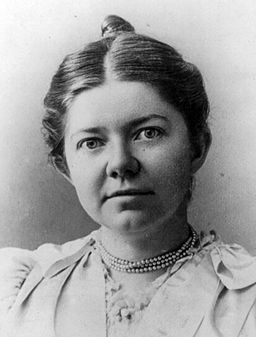 Amy Marcy Cheney Beach (September 5, 1867 – December 27, 1944) was an American composer and pianist. She was the first successful American female composer, and is also known as the first female composer to have her symphony performed by a major orchestra. Additionally, Amy Beach was the first classical U.S. composer to achieve success without the aid of European study.
Amy Marcy Cheney Beach (September 5, 1867 – December 27, 1944) was an American composer and pianist. She was the first successful American female composer, and is also known as the first female composer to have her symphony performed by a major orchestra. Additionally, Amy Beach was the first classical U.S. composer to achieve success without the aid of European study.
Amy lived in a time where women musicians fell into one of two categories: amateur (playing within the home only) and professional (performing in public and paid to do so). Professional women musicians typically had parents who were musicians and performers. Respectable upper-class and middle-class women musicians didn’t perform in public because of the American doctrine of domestic feminism. Women were taught that marriage, home and family were their only domains.
Amy’s mother Clara was a singer and pianist, and had a sister, Emma, that displayed similar talents. Musical skill was clearly present in Amy’s family. At age one, young Amy could already sing 40 songs. She further exhibited her prodigious skills by teaching herself to read at age 3, and writing three waltzes for piano by the age of 4. At the time, highly talented musical students were often sent to Europe for further musical training to pursue a career in music. Amy’s parents did not support the pursuit of European study and for quite some time, Amy was instructed solely by her mother.
At age 9, Amy began studying piano with German-trained Ernst Perabo, who was regarded as one of Boston’s finest pianists and instructors. Perabo taught both privately and at the New England Conservatory. Perabo believed that “the development of the mind requires slow growth, assisted by the warm sun of affection, and guided by conservative teachers with honest and ideal conceptions who understand how to so load its precious cargo, that it may not shift during life’s tempestuous vicissitudes.”
– “Amy Beach, Passionate Victorian: the Life and Work of an American Composer, 1867-1944.” Amy Beach, Passionate Victorian: the Life and Work of an American Composer, 1867-1944, by Adrienne Fried. Block, Oxford University Press, 2000, pp. 23–23.
At age 16 (in 1883), Amy debuted at a “Promenade Concert” in Boston’s Music Hall, playing Chopin’s Rondo in E-flat and was piano soloist in Moscheles’s Piano concerto No. 3 in G minor. She was enthusiastically received.
Amy was married in 1885 at the young age of 18 to Boston surgeon Dr. Henry Harris Aubrey Beach. Henry was 24 years older than Amy. Dr. Beach required his wife stop her public performance. In conformity with his wishes, she stopped performing except for one performance yearly whose proceeds were donated to charity and focused only on composition. Amy Cheney Beach agreed “to live according to his status, that is, function as a society matron and patron of the arts,” and to never teach piano.
Early Amy Beach songs
- The Blackbird, as set by Amy Beach (1889)
- Dark is the night, as set by Amy Beach (1890)
…
op. 1. Four Songs (1887)
- Die vier Brüder (poem by F. von Schiller)
- Jeune fille et jeune fleur (poem by F.R. Chateaubriand)
Self study in composition
As mentioned previously, Amy’s husband, Dr. Henry Beach, forbade her to perform. While she focused on composition, he did not want her taking formal instruction. From wikipedia.org:
Her self-guided education in composition was also necessitated by Dr. Beach, who disapproved of his wife studying with a tutor. Restrictions like these were typical for middle- and upper-class women of the time: as it was explained to a European counterpart, Fanny Mendelssohn, “Music will perhaps become his [Fanny’s brother Felix Mendelssohn‘s] profession, while for you it can and must be only an ornament.”
Amy Cheney Beach’s compositions blazed new territory for women in the Victorian Era. The Mass in E♭, Op. 5, was her first acclaimed success. A 75-minute work for chorus, quartet, organ, and orchestra, it was performed in 1892 by the Handel and Haydn Society orchestra. The orchestra had never, since its inception, performed a work by a woman. In 1896, her Gaelic Symphony was performed by the Boston Symphony Orchestra. The Gaelic Symphony was the first symphony composed and published by an American woman.
Antonin Dvorak, in 1892, remarked that women in music did not have creative power. From the New York Times:
Here all the ladies play,” Dvorak said. “It is well; it is nice. But I am afraid the ladies cannot help us much. They have not the creative power.”
From our collection, op. 51. Four Songs (1903), as set by Amy Cheney Beach:
Amy Cheney Beach was most well-known for her songs. She wrote about 150 songs over the course of her life and career. Mostly, the words for her songs came from other poets, although she and her husband, H. H. A. Beach, wrote the text for about 5 of her songs. “The Year’s At the Spring” from Three Browning Songs, Op. 44 is perhaps Beach’s best-known work.
From our collection, two texts from op. 44, Three Browning Songs (1900), as set by Amy Cheney Beach:
Widowhood, Europe and a return to performance
Amy’s husband died in 1910. Amy felt unable to work, and decided to travel to Europe. It was at this time that she changed her name to Amy Beach. In late 1912, she resumed performing. In late 1913, Amy Beach’s Gaelic Symphony was also performed in Hamburg and Leipzig. From wikipedia.org:
She was greeted as the first American woman “able to compose music of a European quality of excellence.”
op. 73. Two Songs (1914), as set by Amy Beach
When Amy Cheney Beach died, she left more than 300 published works. More of her music has been published in recent decades. After her death in 1944, her music was largely forgotten, but has begun to show a resurgence as of the late 20th century.
View our complete collection of Amy Cheney Beach songs at https://www.ipasource.com/creator/beach-amy-marcy/
